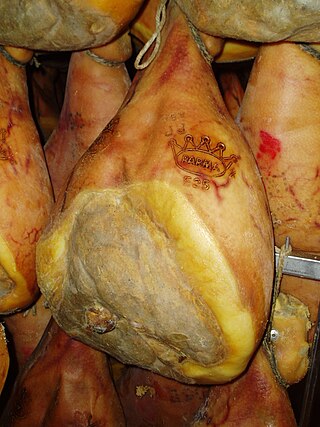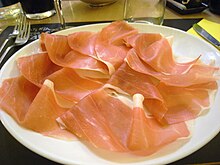
Ham is pork from a leg cut that has been preserved by wet or dry curing, with or without smoking. As a processed meat, the term ham includes both whole cuts of meat and ones that have been mechanically formed.

Mortadella is a large Italian sausage or luncheon meat made of finely hashed or ground cured pork, which incorporates at least 15% small cubes of pork fat. It is traditionally flavoured with black pepper grains, but modern versions can also contain pistachios or, less commonly, myrtle berries. The sausage is then cooked.

A sausage is a type of meat product usually made from ground meat—often pork, beef, or poultry—along with salt, spices and other flavourings. Other ingredients, such as grains or breadcrumbs may be included as fillers or extenders.

Salami is a cured sausage consisting of fermented and air-dried meat, typically pork. Historically, salami was popular among Southern, Eastern, and Central European peasants because it can be stored at room temperature for up to 45 days once cut, supplementing a potentially meager or inconsistent supply of fresh meat. Countries and regions across Europe make their own traditional varieties of salami.

Lunch meats—also known as cold cuts, luncheon meats, cooked meats, sliced meats, cold meats, sandwich meats, delicatessens, and deli meats—are precooked or cured meats that are sliced and served cold or hot. They are typically served in sandwiches or on a tray. They can be purchased pre-sliced, usually in vacuum packs, or they can be sliced to order.

Prosciutto crudo, in English often shortened to prosciutto, is uncooked, unsmoked, and dry-cured ham. Prosciutto crudo is usually served thinly sliced.

Bresaola is air-dried, salted beef that has been aged two or three months until it becomes hard and turns a dark red, almost purple colour. It is made from top (inside) round, and it is lean and tender, with a sweet, musty smell. It originated in Valtellina, a valley in the Alps of northern Italy's Lombardy region.

Capocollo or coppa is a traditional Italian and French (Corsica) pork cold cut (salume) made from the dry-cured muscle running from the neck to the fourth or fifth rib of the pork shoulder or neck. It is a whole-muscle salume, dry cured, and typically sliced very thin. It is similar to the more widely known cured ham or prosciutto, because they are both pork-derived cold cuts used in similar dishes. It is not brined as ham typically is.
Slinzega is a type of air-dried meat produced in Valtellina and Valchiavenna, in the Italian Alps. It is made in a similar manner to bresaola, with smaller pieces of meat, which therefore bear a stronger taste. According to some sources, it originally used horse meat rather than beef. Nevertheless, today virtually any type of meat is suitable for its production; the most common being beef, deer and pork.

In Spanish, cecina is meat that has been salted and dried by means of air, sun or smoke. The word comes from the Latin siccus (dry), via Vulgar Latin (caro) *siccīna, "dry (meat)".

The traditional cuisine of Abruzzo is eclectic, drawing on pastoral, mountain, and coastal cuisine. Staples of Abruzzo cuisine include bread, pasta, meat, fish, cheese, and wine. The isolation which has characterized the region for centuries has ensured the independence of its culinary tradition from those of nearby regions. Local cuisine was widely appreciated in a 2013 survey among foreign tourists.

Salumeria Biellese is a historic Italian deli in Manhattan, New York City, established in 1925. It is located on 8th Avenue and 29th Street in the Chelsea neighborhood.

A salumeria is a food producer and retail store that produces salumi and other food products. Some only sell foods, while not producing on-site, and some have a restaurant with sit-down service. The salumeria originated in Italy, and dates to the Middle Ages.

Salame Felino is a variety of Italian salume historically produced in the comune (municipality) of Felino and in some neighboring comuni, such as Sala Baganza and Langhirano, all in the province of Parma. It is a protected geographical indication (PGI).

Sausages and cured meats are widely consumed in Switzerland. Meat in general is consumed on a daily basis, pork being particularly ubiquitous in Swiss cuisine. Preserving meat by smoking it or by adding salt has been done for millennia in Switzerland.

Salame ticinese is a variety of salami originating in Ticino, the southernmost region of Switzerland. It is characterized by coarsely ground meat and it is often made into small sausages, called salametti. It is an emblematic air-dried cured pork meat of Ticino, along with prosciutto crudo and coppa. These are referred to as salumi.






















